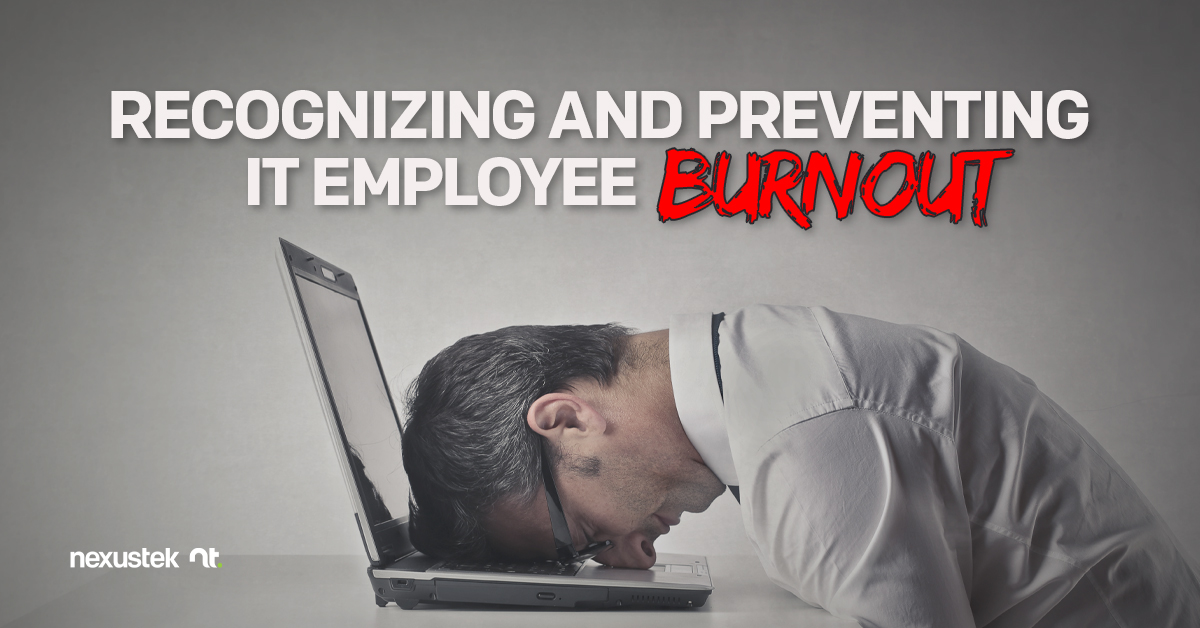READ TIME: 3 MIN

Recognizing and Preventing IT Employee Burnout
The experience of burnout goes beyond simply having a bad day—burnout is a psychological syndrome that results from chronic exposure to adverse or stressful conditions in the workplace. As a business leader, it is important to understand that when your employees are burned out, both they and your business suffer. A Gallup survey revealed that employees who are experiencing burnout are 63% more likely to call in sick, 23% more likely to visit the emergency room, and 2.6 times more likely to be actively seeking another job1.
Many leaders recognize that IT professionals as a group may be at higher risk for burnout, but would you know how to recognize the signs of burnout in your IT staff? Spotting the signs of burnout early and addressing the underlying causes is vital for supporting your IT team’s emotional health and for promoting retention of your top technology professionals. Alarmingly, 42% of IT employees experiencing burnout expressed an intention to leave their jobs within the next 6 months2.
Recognizing the Signs of Burnout
Scholars who specialize in burnout research often describe burnout in terms of three dimensions. These are (a) exhaustion, (b) cynicism, and (c) reduced professional efficacy:
- Exhaustion: Exhaustion is the individual stress element of burnout. When employees are experiencing exhaustion, they may feel depleted or overextended. Importantly, a recent study found that 62% of IT workers reported feeling “physically and emotionally drained,” indicating a vulnerability to burnout3. IT employees experiencing exhaustion may show signs like increased absenteeism and lower energy, and express feelings of being overwhelmed.
- Cynicism: Cynicism constitutes the interpersonal element of burnout. Employees who are experiencing this aspect of burnout may feel distant or disconnected from their jobs and coworkers. They may feel cynical about the importance of their jobs or the company as a whole, feeling as though their work has little meaning or value. Unfortunately, 43% of IT professionals reported feeling less engaged with their work, with 27% expressing a lack of value or purpose in their work, reflecting the experience of cynicism4. IT professionals experiencing cynicism may express negative views about their jobs or coworkers, and exhibit frustration and irritability.
- Reduced Professional Efficacy: A diminished sense of professional efficacy is the self-evaluative element of burnout. When employees feel a lower sense of professional efficacy, they may start to feel negatively about their own performance on the job. They may feel as though they are not up to the demands of their job, or that they are not as productive as they should be. Of concern, 51% of IT professionals feel that they are accomplishing less than they should, and about 33% feel inefficient on the job, suggesting perceptions of lower professional efficacy5. When feeling lower levels of professional efficacy, IT employees may begin to perform at a lower level, have trouble concentrating, or have difficulty with creativity.
Preventing Burnout in IT Employees
Taking effective steps to decrease the likelihood of burnout in IT employees requires understanding the factors that lead to its development. Researchers have found that three of most common factors that predict burnout are (a) unmanageable workload, (b) unreasonable time pressure, and (c) lack of manager support6. Accordingly, a recent study of IT workers found that 2 in 5 were at risk of burnout, due to longer work hours, poor work-life balance, and more demanding workloads7.
An effective strategy for addressing these predictors of burnout in your IT team is co-managing your IT infrastructure with a managed services provider (MSP). Partnering with an MSP can address predictors of burnout in multiple ways:
- Managed help desks take day-to-day, urgent requests for technical support off your IT employees’ hands, reducing time pressure. Relying on a managed help desk also reduces the overall workload for your in-house IT team, reducing the likelihood of burnout.
- Proactive support with routine maintenance tasks (e.g., updates, patching) shifts time-consuming tasks off your IT team’s to-do list, making their workloads more manageable.
- Taking action to reduce your IT team’s workload and time pressure demonstrates manager support for their well-being, which is also important for preventing burnout.
Talented IT professionals can be challenging to find, and showing that you care about their experiences of their jobs is an important part of an effective retention plan. Co-managing your IT infrastructure with an MSP is a practical way of helping your IT professionals to avoid developing burnout, helping you to hang onto your top IT talent.
Would you like to discuss how partnering with an MSP can improve your IT team’s experience?
References:
1,6. Gallup. (2020, March 13). Employee burnout: The biggest myth. https://www.gallup.com/workplace/288539/employee-burnout-biggest-myth.aspx
2,3,4,5,7. ZDNet. (2022, March 4). Tech workers face a ‘burnout crisis’ unless employers act now. https://www.zdnet.com/article/tech-workers-face-a-burnout-crisis-unless-employers-act-now/






